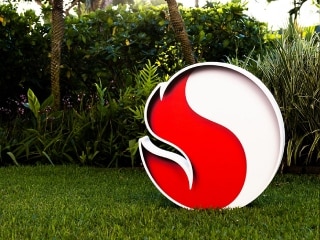- Home
- Wearables
- Wearables Features
- Google and Facebook Chase New Kind of VR Headset
Google and Facebook Chase New Kind of VR Headset

So far, the landscape of virtual reality has been split between two types of headsets: expensive, high-end devices like the Oculus Rift that require PCs and external cameras, and cheap devices like Google's Cardboard and Daydream that use smartphones as displays, sacrificing quality to make a mass-market product. This week, Facebook and Google made it clear that they're both rushing toward a middle ground.
At a conference for developers, Facebook Chief Executive Officer Mark Zuckerberg revealed that Oculus was making a headset that wouldn't require users to tether themselves to a PC. He showed a short video of a prototype that had no wires and seemed to contain the processors in a compartment sitting at the back of the wearer's head. Like so much of what is happening in virtual reality, the presentation was more on the promise of a glorious future than a depiction of anything tangible that is happening in the present day. "I don't want you to get your hopes up yet," said Zuckerberg. "We have a demo, but we don't have a product."
From a technical perspective, a major challenge in creating such a device is devising a way to track a person's movements without a separate camera. So-called positional tracking allows a virtual world to be more responsive to the physical actions made by someone wearing a VR headset. It's one of the fundamental differences between the Oculuses of the world and the Cardboards.
With the Oculus, a camera mounted on a PC watches for the movement of sensors placed on the headset, a technique known as outside-in positional tracking. Having sensors on the device itself do that tracking is known as inside-out tracking. Zuckerberg said this technique was something Oculus engineers are now hard at work on. It's also the focus of Project Tango, an undertaking at Alphabet's Google happening under the auspices of its virtual reality team. Right now, Tango exists separately of Daydream, but a device incorporating both ideas could result in a high-end virtual reality experience powered by a smartphone.
(Also see: Lenovo Phab 2 Pro 'World's First Tango Smartphone' Now Set to Launch in November)
"Everyone's making a big deal of when inside-out mobile positional tracking be solved. Here's a team that's been doing it for awhile," said Clay Bavor, Google's vice president for virtual reality. "Tango is part of my team, so we sit in the same building. You can extrapolate that in several ways." When asked whether he had a timeline for a device that combined Google's smartphone-based virtual reality platforms with the positional tracking of Project Tango, Bavor smiled coyly and said yes. "It's one thing to have the technical capability to do something. It's another thing to get it into a product that people are going to love," he said.
VR developers acknowledge there's just not going to be a huge user base for devices that are as onerous to set up, expensive to run, and as physically constricting as the Oculus or the HTC Vive. Bavor said these dynamics have steered Google away from building a PC-based VR device that competes directly with those from Facebook or HTC. But the simpler devices have technical shortcomings that some developers worry will leave people underwhelmed. When Cardboard was released, there was a backlash about even referring to it as virtual reality. So many people are waiting impatiently for headset companies to figure out products that find a sweet spot that can get full-featured VR to a mass audience, through something that might look at lot like Google's Daydream with inside-out positional tracking. "That, to me, is the golden fusion moment," said Aaron Koblin, chief technical officer at VR developer Within.
(Also see: Daydream View: Google's New VR Headset for the Masses)
Zuckerberg was about as vague as Bavor about putting a timeline on the development of a mid-range VR headset. Not everyone is convinced that such a future is imminent. Shawn Layden, president of Sony Interactive Entertainment, said his company is solely focused on the PlayStation VR, which connects to the company's gaming console and goes on sale later this month. "I think they're two separate and distinct experiences. The high-end console experience you have with the PSVR or the other PC-driven systems really just can't be replicated right now with the cellphone technologies," Layden said. "Who's to say over time whether those converge? I can't."
(Also see: PlayStation VR Is the First Real Mass-Market Virtual Reality Headset)
© 2016 Bloomberg L.P.
Catch the latest from the Consumer Electronics Show on Gadgets 360, at our CES 2026 hub.
Related Stories
- Samsung Galaxy Unpacked 2025
- ChatGPT
- Redmi Note 14 Pro+
- iPhone 16
- Apple Vision Pro
- Oneplus 12
- OnePlus Nord CE 3 Lite 5G
- iPhone 13
- Xiaomi 14 Pro
- Oppo Find N3
- Tecno Spark Go (2023)
- Realme V30
- Best Phones Under 25000
- Samsung Galaxy S24 Series
- Cryptocurrency
- iQoo 12
- Samsung Galaxy S24 Ultra
- Giottus
- Samsung Galaxy Z Flip 5
- Apple 'Scary Fast'
- Housefull 5
- GoPro Hero 12 Black Review
- Invincible Season 2
- JioGlass
- HD Ready TV
- Laptop Under 50000
- Smartwatch Under 10000
- Latest Mobile Phones
- Compare Phones
- OPPO A6 Pro 5G
- OPPO A6s
- OPPO Reno 15 Pro Max
- Honor Win RT
- Honor Win
- Xiaomi 17 Ultra Leica Edition
- Xiaomi 17 Ultra
- Huawei Nova 15
- Asus ProArt P16
- MacBook Pro 14-inch (M5, 2025)
- OPPO Pad Air 5
- Huawei MatePad 11.5 (2026)
- Xiaomi Watch 5
- Huawei Watch 10th Anniversary Edition
- Acerpure Nitro Z Series 100-inch QLED TV
- Samsung 43 Inch LED Ultra HD (4K) Smart TV (UA43UE81AFULXL)
- Asus ROG Ally
- Nintendo Switch Lite
- Haier 1.6 Ton 5 Star Inverter Split AC (HSU19G-MZAID5BN-INV)
- Haier 1.6 Ton 5 Star Inverter Split AC (HSU19G-MZAIM5BN-INV)

















